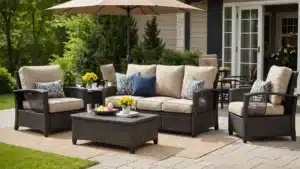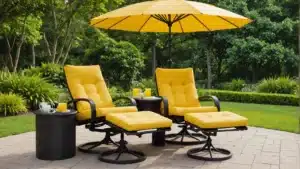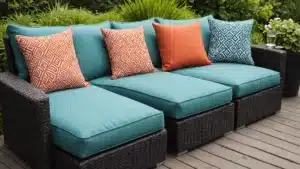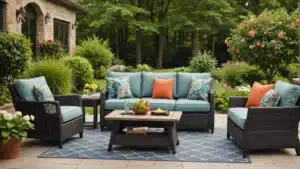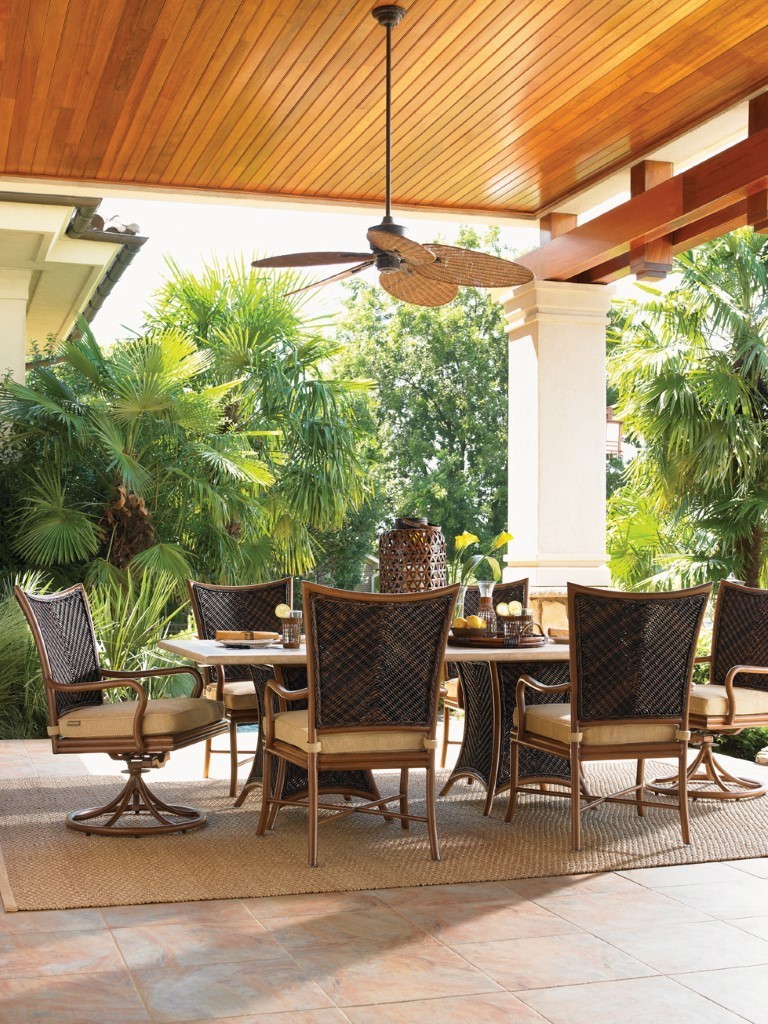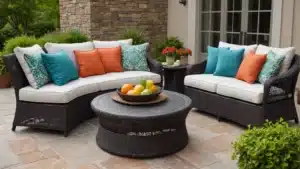Expert Guide to Repairing Patio Furniture

Patio furniture is an essential part of any outdoor living space, offering comfort and style for relaxation and entertainment. However, exposure to the elements can take a toll on even the most durable pieces, leading to wear and tear over time. Whether it’s a wobbly chair, a faded cushion, or a rusted frame, knowing how to repair your patio furniture can save you money and extend the life of your beloved outdoor set. In this expert guide, we’ll walk you through the step-by-step process of diagnosing common issues and implementing effective solutions, ensuring your patio furniture looks and functions like new. Get ready to transform your outdoor space with professional-level repairs that are both simple and cost-effective.
Common issues with Patio Furniture include:.
- Wobbly Chairs : Over time, screws and bolts can loosen, causing chairs to wobble.
- Faded Cushions : Sun exposure can cause fabric to fade and lose its vibrancy.
- Rusted Frames : Metal frames can rust due to moisture and lack of maintenance.
Step-by-step repair process:.
- Inspect the Furniture : Check for loose screws, faded fabric, and rust spots.
- Identify the Cause : Determine whether the issue is due to wear and tear, weather exposure, or lack of maintenance.
- Tightening Screws and Bolts
- Use a screwdriver or wrench to tighten any loose screws or bolts.
- Replace any missing or damaged hardware.
- Reviving Faded Cushions
- Wash the cushions with mild soap and water.
- Consider using fabric dye or purchasing new cushion covers.
- Removing Rust from Frames
- Use a wire brush to scrub off rust.
- Apply a rust converter and then repaint the frame with rust-resistant paint.
Tips for maintaining patio furniture:.
- Regular Cleaning : Keep your furniture clean to prevent dirt buildup and damage.
- Protective Covers : Use covers to shield your furniture from the elements when not in use.
- Routine Inspections : Regularly check for signs of wear and tear and address issues promptly.
By following these steps and tips, you can ensure your patio furniture remains in excellent condition, providing comfort and style for years to come.
Assessing the Damage
Identifying Common Problems
When it comes to assessing damage, the first step is to identify the common problems that may have occurred. This could include visible cracks, water damage, mold growth, or structural weaknesses. Each type of damage requires a different approach for repair, so it’s crucial to accurately diagnose the issue before proceeding. For instance, visible cracks in walls or ceilings can indicate foundational issues or settling, while water damage might be a sign of plumbing leaks or poor drainage. Mold growth is often a result of prolonged moisture exposure and can lead to health issues if not addressed promptly. Structural weaknesses, such as sagging floors or bowing walls, can be indicative of more severe underlying problems that may require professional intervention.
In addition to these common issues, it’s also important to look for less obvious signs of damage. For example, peeling paint or wallpaper can be a sign of moisture problems, while uneven floors might indicate issues with the subfloor or foundation. Unusual odors, such as a musty smell, can also be a sign of mold or mildew. By thoroughly inspecting the area and taking note of all potential problems, you can develop a comprehensive plan for repairs.
Tools and Materials Needed
Once the problems have been identified, the next step is to gather the necessary tools and materials for the repair. Common tools might include hammers, screwdrivers, and wrenches, while materials could range from wood and nails to specialized sealants and adhesives. For more specific repairs, you might need additional tools such as a moisture meter to detect hidden water damage, or a stud finder to locate structural supports within walls.
For addressing water damage, you may need items like wet/dry vacuums, dehumidifiers, and fans to dry out the affected area. Mold remediation might require protective gear such as gloves, masks, and goggles, as well as cleaning solutions specifically designed to kill mold spores. Structural repairs could necessitate more heavy-duty equipment like jacks or braces to support weakened areas while repairs are being made.
Having the right tools and materials on hand will ensure that the repair process goes smoothly and efficiently. It’s also a good idea to have a first aid kit nearby in case of any minor injuries during the repair process. Additionally, if you’re unsure about any aspect of the repair, don’t hesitate to consult with a professional. Properly assessing the damage and being well-prepared with the necessary tools and materials will help you tackle the repairs with confidence and ensure a successful outcome.
Repairing Metal Patio Furniture
Fixing Rust and Corrosion
Rust and corrosion are common issues with metal patio furniture, especially if it is exposed to the elements. To fix rust and corrosion, follow these steps:.
- Clean the affected areas with a wire brush or sandpaper to remove any loose rust. This step is crucial as it ensures that the rust converter and paint adhere properly to the metal surface.
- Apply a rust converter to neutralize the rust and prevent further damage. Rust converters chemically transform rust into a stable compound that can be painted over.
- Wait for the rust converter to dry , which usually takes about 24 hours.
- Apply a primer designed for metal surfaces. The primer acts as a base coat that helps the paint adhere better and provides an additional layer of protection against rust.
- Apply a coat of rust-resistant paint . This will not only restore the appearance of your furniture but also protect it from future rust and corrosion. For best results, apply at least two coats of paint, allowing each coat to dry completely before applying the next.
Regular maintenance, such as cleaning and applying a fresh coat of paint every few years, can help keep your metal patio furniture looking new and rust-free for longer.
Repairing Bent or Broken Frames
Bent or broken frames can compromise the structural integrity of your patio furniture, making it unsafe to use. To repair a bent frame, follow these steps:.
- Assess the extent of the damage . For minor bends, you can use a rubber mallet to gently tap the metal back into shape. Place the furniture on a flat, stable surface and use the mallet to apply even pressure, working slowly to avoid causing further damage.
- For more severe bends, you may need to use a pipe wrench or a vise to apply more force. Secure the bent section in the vise and carefully bend it back into shape, using the pipe wrench for additional leverage if necessary.
- If the frame is broken, you will need to weld the broken pieces back together . Before welding, clean the area around the break thoroughly to remove any dirt, rust, or paint, as this will ensure a strong bond.
- Use a welding machine to join the broken pieces, following the manufacturer’s instructions and safety guidelines.
- After welding, sand the area smooth to remove any rough edges and apply a coat of paint to match the rest of the frame.
If you are not comfortable with welding or do not have the necessary equipment, consider taking the piece to a professional for repair. Regularly inspecting your patio furniture for signs of damage and addressing any issues promptly can help extend its lifespan and ensure it remains safe and functional.
Repairing Wooden Patio Furniture
Dealing with Cracks and Splits
Wooden patio furniture is prone to cracks and splits due to exposure to the elements, such as sun, rain, and temperature fluctuations. These environmental factors can cause the wood to expand and contract, leading to structural issues over time. To address these problems effectively, start by thoroughly cleaning the affected area with a soft brush and soapy water. This will remove any dirt, debris, or mildew that may have accumulated, ensuring a clean surface for repairs. Once the area is dry, inspect the cracks and splits closely.
For minor cracks and splits, wood filler is an excellent solution. Choose a high-quality wood filler that matches the color of your furniture. Apply the filler into the cracks using a putty knife, making sure to press it in firmly to fill the gaps completely. Allow the filler to dry according to the manufacturer’s instructions, which usually takes a few hours. After the filler has dried, sand the area smoothly with fine-grit sandpaper to ensure an even surface that blends seamlessly with the rest of the furniture.
For larger splits or more significant damage, wood glue and clamps are necessary. Apply a generous amount of wood glue into the split, then use clamps to hold the pieces together tightly. Make sure the clamps are positioned correctly to provide even pressure across the split. Leave the clamps in place for at least 24 hours to allow the glue to set fully. Once the glue has dried, remove the clamps and sand the repaired area to achieve a smooth finish. In some cases, you may need to apply wood filler over the glued area to fill any remaining gaps and then sand it again.
Refinishing and Sealing
Refinishing your wooden patio furniture not only enhances its appearance but also extends its lifespan by protecting it from the elements. Begin the refinishing process by sanding the entire piece of furniture. Use medium-grit sandpaper to remove any old finish, paint, or varnish, and to smooth out any imperfections in the wood. After the initial sanding, switch to fine-grit sandpaper to achieve a smooth, even surface. Wipe down the furniture with a damp cloth to remove any dust and debris from sanding.
Next, choose a wood stain or paint that complements your outdoor decor. When applying the stain or paint, follow the manufacturer’s instructions for the best results. Use a high-quality brush or a clean cloth to apply the stain in the direction of the wood grain, ensuring even coverage. Allow the stain to penetrate the wood for the recommended time before wiping off any excess with a clean cloth. If you prefer a darker color, you can apply additional coats, allowing each coat to dry thoroughly before applying the next.
Once the stain or paint has dried completely, it’s time to apply a sealant. A good sealant will protect the wood from moisture, UV damage, and other environmental factors. Choose a sealant that is specifically designed for outdoor use and apply it evenly with a brush or sprayer. Make sure to cover all surfaces, including the undersides and any crevices, to provide maximum protection. Allow the sealant to dry according to the manufacturer’s instructions, which may take several hours or overnight.
Regular maintenance is crucial to keep your wooden patio furniture looking great and ensuring its durability. Inspect your furniture periodically for any signs of wear or damage, and reapply the sealant every few years to maintain its protective barrier. By taking these steps, you can enjoy your beautiful wooden patio furniture for many years to come.
Repairing Wicker Patio Furniture
Mending Broken Weaves
Wicker furniture is known for its durability and aesthetic appeal, but over time, the weaves can break or become loose. To mend broken weaves, start by identifying the damaged areas. Use a pair of scissors to trim any frayed ends. Next, soak a new piece of wicker in water for about 30 minutes to make it more pliable. Weave the new piece into the existing pattern, ensuring it follows the original design. Secure the ends with a dab of wood glue and allow it to dry completely before using the furniture again.
If the damage is extensive, you might need to replace entire sections of the weave. In such cases, it’s advisable to consult a professional or refer to detailed guides that can walk you through the process step-by-step. Additionally, always ensure that the new wicker matches the color and texture of the existing material to maintain a uniform look.
Cleaning and Preserving Wicker
Regular cleaning is essential to maintain the longevity of your wicker patio furniture. Begin by dusting off loose dirt and debris with a soft brush or vacuum cleaner. For a deeper clean, mix a solution of mild soap and warm water. Use a soft cloth or sponge to gently scrub the wicker, paying special attention to crevices. Rinse with clean water and allow the furniture to air dry completely.
To preserve the wicker, apply a thin coat of furniture wax or a specialized wicker sealant. This will protect the material from moisture and UV damage, ensuring your furniture remains in excellent condition for years to come. Additionally, consider placing your wicker furniture in a shaded area or using furniture covers when not in use to further protect it from the elements.
During the off-season, store the furniture indoors or in a dry, sheltered area to prevent unnecessary wear and tear. Regular maintenance, such as tightening loose screws and checking for signs of wear, can also extend the life of your wicker furniture. By following these steps, you can enjoy the beauty and functionality of your wicker patio furniture for many years.
Repairing Fabric and Cushions
Patching and Sewing Tears
When it comes to maintaining the longevity of your furniture, addressing tears in the fabric promptly is crucial. Small rips can quickly become larger, more problematic issues if left unattended. To patch and sew tears, start by selecting a fabric patch that matches the color and texture of your existing upholstery. Clean the area around the tear thoroughly to ensure a strong bond. Use a needle and thread to sew the patch onto the fabric, making sure to use small, tight stitches to prevent further fraying. For larger tears, consider using an iron-on patch for added durability. Additionally, if you are not confident in your sewing skills, you might want to use fabric glue as a temporary fix. However, keep in mind that fabric glue is not as durable as sewing and may need to be reapplied over time.
For those who prefer a more professional finish, consider using a sewing machine. A sewing machine can provide stronger and more consistent stitches, which can be particularly useful for larger tears or thicker fabrics. If the tear is located in a high-stress area, such as the edge of a cushion or a frequently used armrest, reinforcing the patch with additional stitching or even a second layer of fabric can provide extra durability.
Replacing Foam and Padding
Over time, the foam and padding in your cushions can become compressed and lose their shape, leading to discomfort and a less aesthetically pleasing appearance. Replacing the foam and padding can breathe new life into your furniture. Begin by removing the cushion covers and taking out the old foam. Measure the dimensions of the cushion to ensure you purchase the correct size and density of foam. Cut the new foam to fit, and consider adding a layer of batting for extra softness. Insert the new foam into the cushion cover, making sure it fits snugly and evenly. This simple update can significantly improve both the comfort and look of your furniture.
When selecting new foam, it’s important to consider the density and firmness. High-density foam tends to be more durable and provides better support, making it ideal for frequently used furniture. On the other hand, low-density foam is softer and may be more suitable for decorative cushions that are not used as often. Additionally, memory foam can be a great option for those looking for extra comfort, as it conforms to the shape of your body.
If your cushions have lost their shape due to worn-out padding, adding a layer of batting can help restore their original form. Batting is a soft, fibrous material that can be wrapped around the foam to add extra cushioning and create a smoother appearance. To apply batting, cut it to size and use a spray adhesive to attach it to the foam. Make sure the batting is evenly distributed to avoid lumps and bumps in the cushion.
In some cases, you may also need to replace the cushion covers if they are too worn or damaged. When choosing new covers, look for durable, easy-to-clean fabrics that match your existing decor. Removable and washable covers can be particularly convenient, as they allow you to keep your cushions looking fresh and clean with minimal effort.
By taking the time to patch and sew tears, replace foam and padding, and possibly update cushion covers, you can extend the life of your furniture and keep it looking and feeling comfortable for years to come.
Preventative Maintenance Tips
Regular Cleaning and Inspection
One of the most effective ways to ensure the longevity and optimal performance of your equipment is through regular cleaning and inspection. Dust, dirt, and debris can accumulate over time, leading to potential malfunctions or decreased efficiency. Make it a habit to clean your equipment according to the manufacturer’s guidelines. This might include wiping down surfaces, cleaning filters, and ensuring that moving parts are free from obstructions. Additionally, inspect for any signs of wear and tear, such as frayed wires, loose screws, or rust. Early detection of these issues can prevent more significant problems down the line. For instance, a frayed wire could lead to electrical shorts, while rust can weaken structural components. Regular inspections can also help you identify parts that may need lubrication or replacement, ensuring that your equipment runs smoothly and efficiently.
Regular cleaning and inspection are not just about maintaining appearances; they are crucial for the safety and functionality of your equipment. For example, in industrial settings, accumulated dust can pose a fire hazard, while in medical equipment, cleanliness is essential to prevent contamination. Therefore, adhering to a strict cleaning and inspection schedule can mitigate these risks. Moreover, keeping a log of your maintenance activities can be beneficial. This log can help you track the condition of your equipment over time and identify recurring issues that may need more permanent solutions.
Protective Covers and Storage
Using protective covers and proper storage solutions can significantly extend the life of your equipment. When not in use, cover your machinery to shield it from dust, moisture, and other environmental factors that can cause damage. Protective covers are especially important for outdoor equipment, which is more susceptible to weather-related wear and tear. Store your equipment in a dry, cool place to avoid exposure to extreme temperatures and humidity, which can lead to corrosion and other issues. For example, storing equipment in a damp environment can cause metal parts to rust and electrical components to short-circuit. Investing in high-quality protective covers and storage solutions is a small price to pay for the long-term benefits of maintaining your equipment in top condition.
Additionally, consider using desiccants or dehumidifiers in storage areas to control moisture levels. Proper storage not only protects your equipment but also makes it easier to organize and access when needed. For instance, labeling storage areas and using shelving units can help you quickly locate the equipment you need, reducing downtime. Furthermore, consider the use of climate-controlled storage for sensitive equipment that may be affected by temperature fluctuations. This is particularly important for electronic devices and machinery with intricate components that can be damaged by extreme conditions.
By taking these preventative measures, you can ensure that your equipment remains reliable and efficient for years to come. Preventative maintenance is an investment in the longevity and performance of your equipment, ultimately saving you time and money in the long run. Whether you are managing a small workshop or a large industrial facility, these tips can help you maintain your equipment in top condition, ensuring that it is always ready to perform when you need it.
Conclusion
Repairing your patio furniture like a pro doesn’t have to be a daunting task. With the right tools, materials, and a bit of know-how, you can extend the life of your outdoor pieces and keep them looking their best for years to come. Whether you’re dealing with minor wear and tear or more significant damage, following the expert tips and techniques outlined in this guide will help you tackle any repair project with confidence. Remember, regular maintenance and timely repairs not only enhance the appearance of your patio furniture but also ensure its functionality and comfort. So, roll up your sleeves, get to work, and enjoy your beautifully restored outdoor oasis!.





